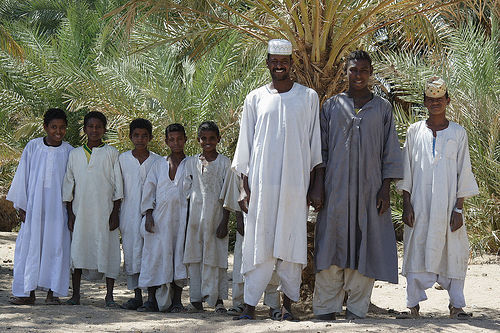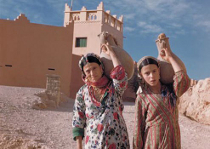Sijilmassas was founded by Kharijites and their followers in 757: so the story goes. Sometimes I wonder about these founding claims, though. Wasn’t there anyone living on the fertile banks of the Ziz river in 757?

“Sedentary peoples may have settled the oasis as early as fourth century BC, depending on irrigated agriculture and herding for a living.”[1] Those sedentary people might (still speculatively) have been the ancestors of the Haratine: dark-skinned, African-featured inhabitants of the Tafilalt, hereditarily constrained to the status of indentured servants, tied to the land and working for Arab, Berber, or Jewish inhabitants of the oasis.

(both images–“Haratine girl in Morocco” and “Haratine” above–web caught)
Huh? So the Haratine, potentially the “original” inhabitants of the Ziz region, lost control over the land to newer arrivals, and were themselves compelled to labor for their oppressors? Doesn’t that all seem depressingly familiar and predictable?
Let’s try a different recap:
Arabs (the Kharijites) and Amazigh [Berbers] (Zenata) settle Sijilmassa on the labor of the Haratine; Jews and other merchants (like the Genoese in the 1300s) settle in Sijilmassa, both financing the salt trade and, at least in the case of the Jews, working as artisans. Slaves, moving through Sijilmassa to the north, also constituted a significant portion of the population.
According to Dumper and Stanley, Jewish networks “along the major North African and trans-Saharan routes [were] a crucial facilitator in building Sijilmassa’s monopoly. They [Jews] were also important artisans, providing specialist skills as metalworkers, jewelers, tailors, cobblers, and carpenters. Their community prospered, and the Tafilalt Abuhatzira family in particular became regionally known for their piety and rabbinic influence.”
 Jewish women in Tinghir
Jewish women in Tinghir
But only Arabs and the Berbers could own property–so the system was rigged to make race into a class issue. Arabs and Berbers could own land; Jews could not, but they could amass wealth; Haratine were limited to sharecropping, subordinated to specific families; slaves lived with Arab, Berber, or Jewish families. Comparisons are invidious, we know, but some would say that slaves–mostly domestic servants and concubines–were better off than the Haratine, who held a role not unlike that of a field slave in the antebellum American South.
The French attempted to leave tribal relations more or less intact (once the area was “pacified”), but their intervention in the region opened new possibilities. Jews were the first Moroccans to adopt the French language; the large Moroccan-Jewish community emigrated to Israel en masse in the years after independence. During the Protectorate, large numbers of Haratine migrated to southern Algeria or Morocco (later, to Europe) in search of work. Unlike Arabs and Berbers, the Haratine had nothing to lose at home–and the money they sent back to the Tafilalt enabled Haratine families to purchase land and trees, acquire cultural capital, and earn at least a few places on village councils, much to the displeasure of prior power-holders.
(By contrast, the Haratine in Mauritania continue to suffer state-based discrimination. Slavery was criminalized in 2007, but anti-slavery court cases are backlogged and slow to progress. And in 2011, a new census, designed to systematize national identity documents, recognized only four ethnic groups (Moorish, Soninké, Fulani, Wolof), and failed to mention the Haratine, often considered “Black Moors,” who by some counts constitute roughly 40% of the population. See http://www.minorityrights.org/5179/mauritania/haratin.html.)
But if power relations in the Tafilalt and other Moroccan oases have shifted somewhat, ethnicities remain distinct, much as they do in the American “melting pot” where melding is more obvious in social claims than in reality. And the oases themselves are threatened by ecological challenges, particularly the ever-deepening demand for irrigation.
1. Michael Dumper and Bruce E. Stanley, eds., Cities of the Middle East and North Africa: A Historical Introduction, ABC-CLIO, 2007.
See also Hsain Ilahiane, Ethnicities, Community Making, and Agrarian Change: The Political Ecology of a Moroccan Oasis (University Press of America, 2004), and Anna Natividad Martinez, “Intertribal Conflicts and Customary Law Regimes in North Africa: A Comparison of Haratin and Ait ‘Atta Indigenous Legal Systems” (http://tlj.unm.edu/tribal-law-journal/articles/volume_5/intertribal_con…omparison_of_haratin_and_ait_atta_indigenous_legal_systems/content.php).